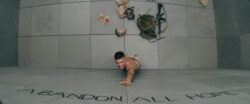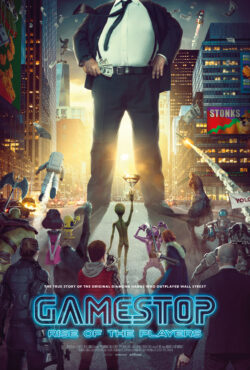Starring: Robbie Banfitch, Angela Bosolis and Scott Shamell
Directed by: Robbie Banfitch
Rated: NR
Running Time: 100 minutes
According to the San Francisco Gate, 1-2 people die every year In the Mojave Desert, specifically because it’s home to Death Valley. The iconic national park is known for its unforgivable heat, a record of 134 degrees in 1913, and being the driest and having the lowest elevation on the North American continent. It seems like every fact involving Death Valley, or even the Mojave Desert, is dreadful in its own unique way. But a new reason to avoid these three million acres will be found on three video camera memory cards.
The first memory card in “The Outwaters” shows us four people who aren’t necessarily brave enough to venture into Death Valley for fun, but more or less, have a legitimate reason. Robbie (Banfitch) is directing a music video for musician Michelle (Michelle May). In tow are his brother and a make-up artist, with the men in one tent and the women in another. They aren’t ignoring any warning signs or ominous news reports before they head off into the hottest place in the world. In fact, nothing would lead them to believe they are in danger, until night falls on their first night in the desert.
In the dead of night, a booming, rattling noise is heard. Not once, not twice, but repeatedly. It awakens everyone, but no one can see the cause. Is it a nearby vehicle? Is it the distant sound of thunder from a storm? Is it otherworldly? After some tense moments, they ease their nerves by settling on the idea that it’s distant thunder, but the idea seems false. We see it on their faces as they go back into their tents. Soon though, that’s not the only disturbing thing to happen and when the proverbial shit hits the fan, it’s sudden and frightening.
“The Outwaters” spends a decent amount of time setting everything up like pieces on a chess board. While I assume most people will be checking their phones during this, the set-up is crafty in that it feels realistic, natural and ultimately foreboding. It’s like a warm sip of cocoa before being shoved into an ice-cold lake. The second half of the film can only be described as bloody, trippy and ultimately nightmarish.
What made “The Blair Witch Project” a jumping off point for those in horror in 1999, is seen once again in “The Outwaters.” Banfitch (who writes, directs, stars, edits and probably did damn near everything else) pulls out all the stops to lull us into safety before throwing us in the hellish fires of his final act, which are equally unexplainable and hard to watch. The simplicity of the shots is never grotesque, but the ideas they convey take our minds to some morbid places about what is potentially happening to Robbie and the others.
As I’ve noted before and very recently, the found footage genre is a difficult one, with very few finding a unique and different way to tell the story, but “The Outwaters” almost feels like a rebirth, making you forget about the clichés of the genre as well as some other nagging questions that arise when you watch a found footage film. For instance, why does Robbie keep filming? In the darkness of the desert, it’s the only light he has to see with and if he turns it off, what demons/monsters/aliens are waiting to pounce? We feel for him as he cries and moans with every new moment he captures on his digital handheld. Eventually it feels like “The Outwaters” transcends the found-footage genre as it becomes viler and more repulsive. This is definitely the closest we’ll ever get to someone’s nightmare coming to life on-screen.
















